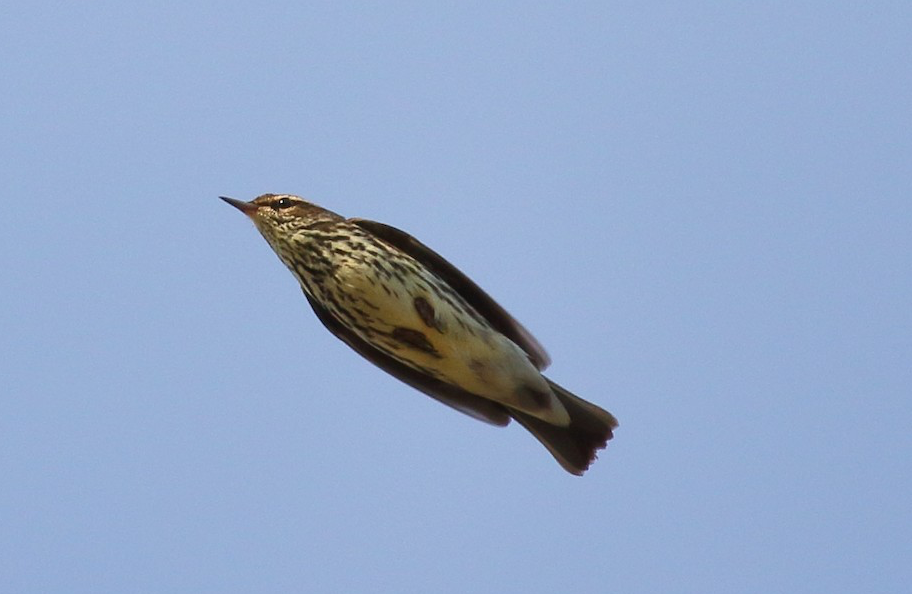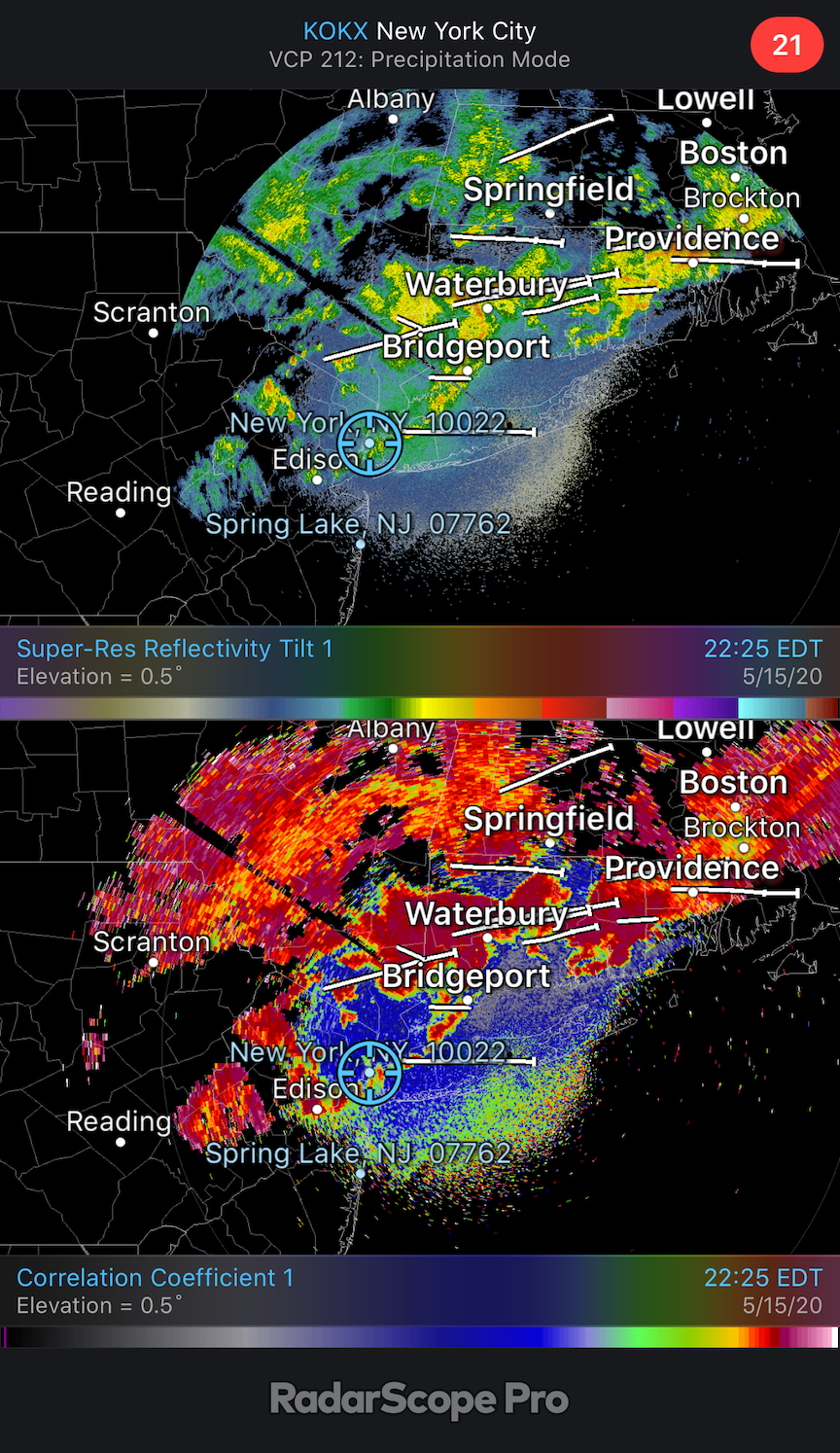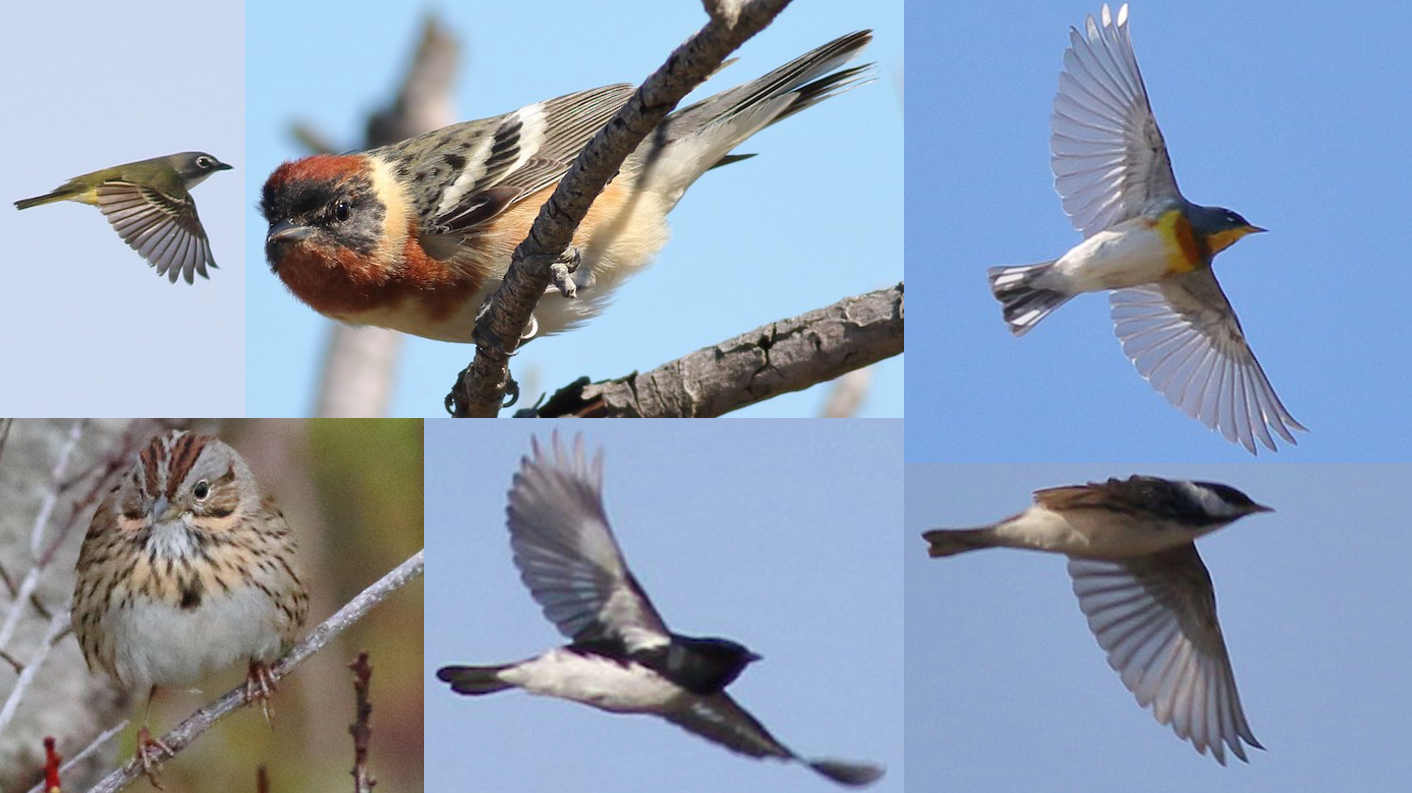
A Northern Waterthrush in flight, one of 35 observed on the morning of 16 May 2020 at Provincetown Airport, from a decidedly odd and unfamiliar perspective for those that have not experience morning flights of nocturnal migrants!
Team BirdCast thoroughly enjoys insight from our esteemed colleagues, and in this guest post we hear firsthand about experiences of Sean M. Williams and an array of colleagues with a massive migration event on the coast on the morning of 16 May 2020 in Massachusetts. This set of observations relates as groundtruth for this Birdcast post (and prediction), alerting birders to potential fallout conditions. This type of account is invaluable, both for preservation in the hallowed halls of science as much as in recapitulations among friends and colleagues of amazing migration spectacles, shaping our understanding how birds respond to potentially challenging situations. And the sheer number of passing songbirds from a point of observation on the ground highlights the connection between what we see on the ground and what we sense in the air, at night, with radar. We look forward in the coming years to more opportunities to relate patterns we can see to patterns we can sense, as it is in these relationships that much science and conservation is seeded and ready to grow! Now, without further ado, take it away, Sean!
The Setup
The spring of 2020 has been marked by north winds and wet conditions, which has severely stalled May migration across the Northeastern U.S.—such unfavorable conditions have been especially prevalent since mid April (for example, this brief discussion of the weak polar vortex). Prior to 14 May, the most recent significant movement occurred 2-3 May. Most Neotropical passerines that typically arrive during the second to third weeks of May were delayed by 7-10 days. On the night of 14 May, warm temperatures and southwest winds finally produced a large movement. Throughout the night, birds were moving northeast in coastal New England and the mid-Atlantic states. Local midnight (approximately) saw medium to locally high intensity movements across much of the northeastern US, generally moving to the northeast. By early morning in the hours just before dawn, movements continued primarily in a northeasterly direction along the coast. A new suite of migrants arrived successfully into the northeastern US. This suite of movements was associated with a warm front moving into the region in advance of an approaching frontal boundary farther west.
 This suite of movements was associated with a warm front moving into the region in advance of an approaching frontal boundary farther west. Birds in areas of peak movement mostly avoided areas of scattered rain and more intense storms, but some concentrations clearly occurred (see previous BirdCast post with checklist links). Birds in areas of peak movement mostly avoided areas of scattered rain and more intense storms, to some extent because of the timing and orientation of the frontal passage (see this link).
This suite of movements was associated with a warm front moving into the region in advance of an approaching frontal boundary farther west. Birds in areas of peak movement mostly avoided areas of scattered rain and more intense storms, but some concentrations clearly occurred (see previous BirdCast post with checklist links). Birds in areas of peak movement mostly avoided areas of scattered rain and more intense storms, to some extent because of the timing and orientation of the frontal passage (see this link).
The Action
Shortly after nightfall, a line of severe thunderstorms along a frontal boundary swept northwest to southeast, and arrived to the northern New England coast between 9-10 pm. At this time, the system still was well inland in the rest of the Northeast, where warm temperatures and southwesterly winds were favorable for migration. As night fell and the storm advanced toward the southern New England coast, radar indicated high intensities of migration in coastal New Jersey, New York, and Connecticut. The dearth of migratory activity for two weeks had intensified migratory restlessness (i.e. zugunruhe), so birds were determined to move.

The two panel figure below captured from RadarScope Pro, shows reflectivity and correlation coefficient products from the KOKX radar (the radar is on Long Island, the cross hairs represent the location of Andrew Farnsworth’s cell phone in grabbing these data). These products’ patterns in combination are critical for properly interpreting and framing these movements. For our purposes, the distributions of the uniform and stippled blue pattern in the top panel are characteristic of biological activity in the atmosphere (in this case, birds migrating), while the blocky yellow and red indicates precipitation. The bottom panel is sampled at the same time, and in the correlation coefficient color scheme the blue colors correspond to the migrating birds and the red to rain – note that the patterns suggest that birds are moving between rain over Connecticut and Rhode Island (white lines represent more intense storm cells, all moving east and northeast).

The southwesterly tailwinds early in the night drifted many birds further east than they typically occur (Cape Cod is notoriously slow for passerines in spring migration). Migration maps from 16 May 0100, 0300, 0400, and 0450 EDT confirm a strong east-northeast component to many movements of birds on Long Island and coastal New Jersey from 9 pm through 4 am. Intense precipitation in conjunction with dense cloud cover likely limited migrants’ ability to avoid flying over water. Therefore, many birds drifted offshore in southeast New England.
Intense storms reached the southern New England Coast between 11 pm-4 am (see Paul Hurtado’s archive site for imagery with precipitation and biology aloft). Large numbers of migrants – up to 8,000-10,000 birds passing per kilometer per hour – were either forced to the ground or remained volant if over water.
At first light (~5 am), any birds over water presumably headed to the closest land, which for a large number of birds was the outer portion of Cape Cod. Any land will suffice for migrating birds experiencing significant precipitation and turbulent winds (see Buler and Moore 2011). Around 6 am, as the sun rose and the strong cold front moved storms to the south, thousands of misoriented migrants returned to the air to reposition geographically and offset their wayward travels. Additionally, it’s worth pointing out that the habitat on Cape Cod is dominated by scrub pine and sandy soils, supporting relatively few insects. This limited foraging opportunity may have contributed to the magnitude of reorienting “morning flight” behavior. By 06:30 (after frontal passage), a mass exodus from the pine forests resulted in birds flying north and west on outer Cape Cod. The counterclockwise curvature of the northern tip of Cape Cod combined with the birds’ unwillingness to cross water concentrated them along the northern edge of the tip in Provincetown. Two parties watching from High Head (about 9 km east of Provincetown) detected thousands of warblers migrating as well (checklists here and here). Their combined observations confirms separate flight lines (one to the north and one to the south) that then converged as it neared Provincetown further west. From 07:00-10:00, they streamed over the sand dunes between the Provincetown Airport and Race Point Beach, heading west. They continued out of sight and it’s unclear where they went after that. Some birds landed in the nearby forests, but others may have continued over the ocean or potentially wrapped back southward near Herring Cove.
The Morning
My day had a rough start: the alarm sirened at 02:30, an unfortunate cacophony to hear in a daze. I procured only four hours of sleep because I had stayed up late rooting for a severe thunderstorm to hit the coast in the middle of the night. A rare intersection between extreme weather and restless migrants historically has produced a “fallout,” resulting in huge numbers of grounded birds on the coast. The storms started too early on the north coast of Massachusetts, so all hope had been placed on the later arrival of the storms on Cape Cod. Downpours characterized the entire two-hour drive to Provincetown. Upon pulling into the entrance of the airport at 05:15, 50 birds flushed in my headlights and I slammed on the brakes. There were a couple hundred birds, mostly sparrows and a few warblers, on the pavement and in bushes at the edges of the small parking lot. Their feathers were wet and matted, with many birds shaking off. They stood in the parking lot, some preening, some pecking at the ground, and some motionless. As the sky got lighter, they became more active, mostly foraging on the ground for seeds, with some singing. Several warning pecks and chases spoke to the high density of grounded birds with peak hormone levels–birds do not take well to being packed too closely! The slight majority of sparrows were Savannah, with the remainder mostly made up of Lincoln’s and White-crowned, with Lincoln’s outnumbering White-crowned (!). At the same time, groups of 10-20 warblers were arriving from the west and north, clearly coming in off the ocean. The groups were fairly high—about 100-200m above the ground. As they passed over the thicket, which is the first significant vegetation coming from the ocean, they free fell vertically in unison with their wings completely tucked and bills pointed directly downward. About 3m over the thickets, they broke from their synchronized formation and scattered in different directions, darting into the vegetation at surprising velocity, like little feathered bullets. The tightness and unity of their movements were noteworthy—unlike the typical loose form of warbler flocks, and more like a school of fish. By 07:00, warbler groups started flying high overhead from the east and continuing west. At 07:15-07:30, the distant northern skies were clearing, the sun peeked out, and an 8 mph northern breeze picked up. The warblers then started flying much closer to the ground, so I positioned myself atop a dune with a good view in all directions. Most warblers were flying from eye level to 15 m high. At 07:55, the trickle of a dozen or two warblers per minute turned into a steady stream beginning with a group of 40 birds, shortly followed by another 50. For the next 30 minutes, a solid flow of warblers came from east to west, passing by my position at a rate of 100 individuals/minute. Some were flying directly overhead, some to my north, as well as to my south. At 08:30, Peter Trimble, a seasoned veteran with over 50 years’ experience birding Cape Cod, joined the morning flight vigil. The wind increased further from the northwest (~10-15 mph), and the flight line along the dunes to the north dissipated, which concentrated birds along a flight line that was lower to the ground on the leeside of the dunes below us. The peak numbers dissipated just after 09:00, and slowly tapered off until we left at 10:30 am. Between 07:00-10:15, we tallied 4880 warblers of 25 species. The morning was filled with many highlights, but from a historical perspective, the following observations stand out:
The tallies of 114 Bay-breasteds and 181 Cape Mays are particularly noteworthy because Bay-breasted and Cape May Warblers historically have been the least common of the regular migrant warblers in Massachusetts. These apparent increases in their populations seem to be connected to recent outbreaks of the spruce budworm population in the northeastern boreal forests (see Morse, Drever et al, and Kamm et al for some discussions of this). One early group of 50-60 warblers contained about 30 Bay-breasteds, with rest being mostly Cape Mays.
At least 66 Lincoln’s Sparrows were counted, which is an uncommon species in the spring in Massachusetts, particularly on Cape Cod. A full morning of birding during their peak migration may or may not turn one up. The previous spring high count for Lincoln’s Sparrows in Massachusetts occurred during a similar massive coastal fallout on 12 May 1996, with 22 on Plum Island, Newburyport. Cape Cod’s spring high count occurred that same day, with four at the Beech Forest, Provincetown (Blair Nikula). To observe 16 in view at once and a minimum total of 66 individuals is unprecedented. White-crowned Sparrow counts likewise were unusual. Lincoln’s generally is a secretive and underdetected species, yet conditions set these birds in a conspicuous place different from typical thickets for hiding.

A small sample of the birds reported in eBird checklist S69283462. From the left: top row, Blue-headed Vireo; Bay-breasted Warbler; Northern Parula; bottom row, Lincoln’s Sparrow; Black-throated Blue Warbler; Blackpoll Warbler.
Blair Nikula, who has birded the Cape intensively for over 50 years, provided some historical context on the staggering individual totals. New high spring counts for Cape Cod were recorded for 22 species; in most cases these were new highs for any season (Table 1). Moreover, some counts set new all-time records for Massachusetts (denoted by * in Table 1). Blair writes, “In most cases, these old highs were not just broken; they were smashed, shattered, and crushed into oblivion!” Thanks to Blair for providing these data.
| Species | Previous | New |
| Solitary Sandpiper | 4 | 14 |
| Least Flycatcher | 5 | 25 |
| Eastern Kingbird | 22 | 210* |
| Blue-headed Vireo | 25 | 45 |
| White-crowned Sparrow | 8 | 58 |
| Savannah Sparrow | 15 | 250 |
| Lincoln’s Sparrow | 4 | 66* |
| Bobolink | 40 | 122* |
| Baltimore Oriole | 45 | 88 |
| Northern Waterthrush | 20 | 35 |
| Black-and-white Warbler | 95 | 420* |
| Nashville Warbler | 45 | 60 |
| Common Yellowthroat | 41 | 120 |
| Cape May Warbler | 40 | 181* |
| Northern Parula | 40 | 890* |
| Bay-breasted Warbler | 20 | 114* |
| Chestnut-sided Warbler | 22 | 26 |
| Black-throated Blue Warbler | 20 | 140 |
| Yellow-rumped Warbler | 400 | 770 |
| Black-throated Green Warbler | 43 | 160 |
| Wilson’s Warbler | 20 | 34 |
| Scarlet Tanager | 6 | 26 |
Additionally, unusual taxa for the date or location included an Olive-sided Flycatcher, a Lapland Longspur, two Clay-colored Sparrows, a “Gambel’s” White-crowned Sparrow, a Vesper Sparrow, an Orange-crowned Warbler, a “Western” Palm Warbler, and two Summer Tanagers. Additional rare species found by others in the area include a Gray-cheeked/Bicknell’s Thrush, a Golden-winged Warbler, a Hooded Warbler, a Blue Grosbeak, and at least three other Summer Tanagers.
Liam and Maili Waters and Will Sweet et al. focused on morning flight at High Head, 5 miles to the ESE as the warbler flies. Liam and Maili focused on a flight line to the south of High Head, and Will Sweet and company confirmed a second flight line on the north side. These two flight lines converged to the west of High Head, forming a single concentrated flight line coursing over the dunes toward Provincetown. These observers noted high numbers of Northern Parulas as well. Most of their warbler ratios were similar and sparrows numbers were in elevated numbers too. It is most fortunate that these critical data were collected, and without them we would have a significantly less complete picture of this historical event.
Several additional checklists by other observers highlight the diversity of this intense reorganization and continuation after a suite of challenging migration conditions: Shank Painter Pond, Beech Forest, Kings Highway to Longnook Bluffs, White Horse Beach, and Shallow Pond.
Meanwhile …
The rest of the Massachusetts coast had large numbers of birds on the ground, with above average concentrations of migrants and a fair number of scarce species scattered from Orleans to Manomet, to Cape Ann and Plum Island. The only other reorientation flight observation was from Wingaersheek Beach, a newly discovered site for morning flight, where the flight was earlier and concentrated in a very active window from 5:40-6:20, suggesting that these were mostly birds grounded very nearby and not moving great distances like at Cape Cod. Unlike Cape Cod, Marshall Iliff’s checklist records that the vast majority of 1360 warblers were Yellow-rumped Warblers (775), with the majority of 485 unidentified warblers also likely this species; Northern Parula was the second most common but the count of 41 indicated a significant difference in flight composition from Cape Cod, perhaps because this site was farther north of the frontal boundary and fewer birds, especially new arrivals, were able to penetrate the line of storms.
Closing Thoughts
This surely was a once-in-a-lifetime experience to overwhelm, humble, and inspire. The spectacle offered a unique chance to ponder the interaction between migratory birds and weather. Birds possess refined mechanisms for migrating in hazardous situations, e.g. drifting over open ocean during turbulent winds, intense rain, and low visibility, and finding a brief shelter when necessary. Yet, critical components of migration are externalities, like local geography and availability of habitat for resting. Cape Cod’s landscape provided a fortuitous oasis in otherwise hostile conditions. The fervor from that fateful morning will be ingrained in our memories forever. We were but a handful of humble, motionless figures observing a rare and ephemeral phenomenon from the ground, perhaps unlikely to cross paths with any of these individual birds again.
Sean M. Williams




